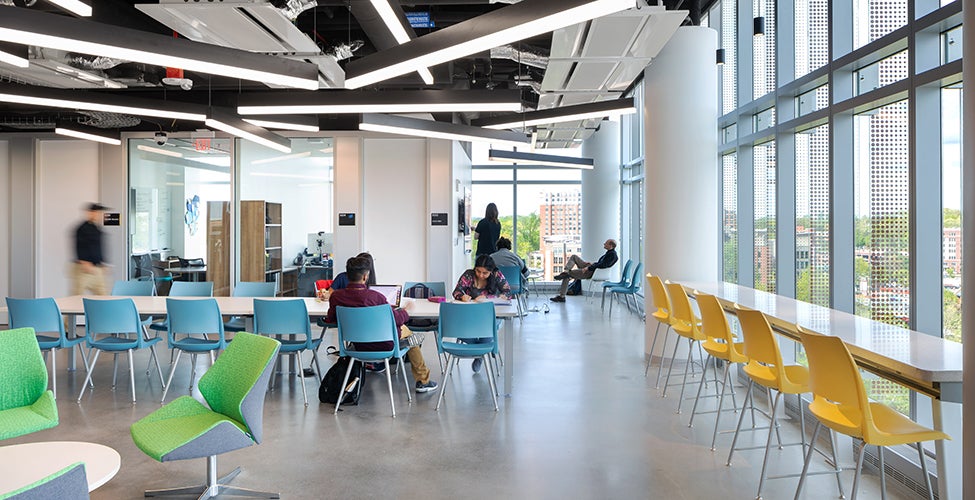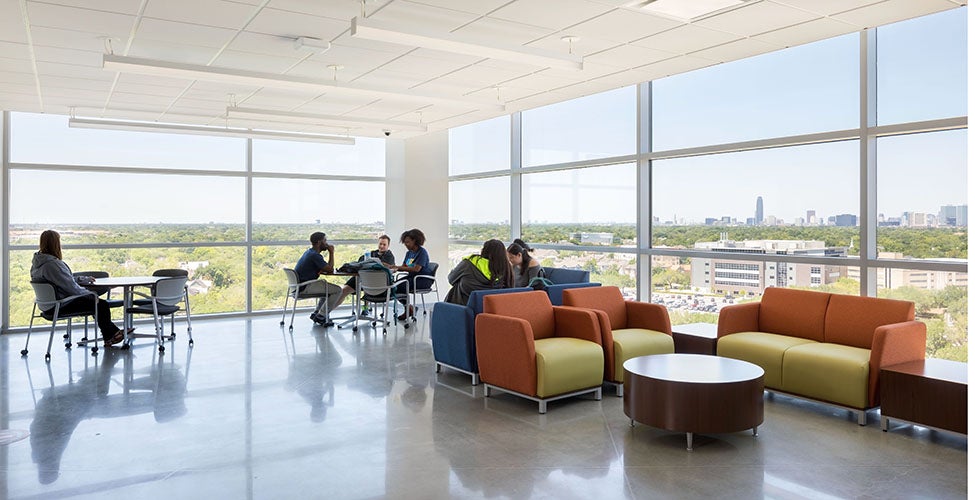
What the Future of Higher Education Means for Office Space
Staff office space and office strategies are currently being reassessed for university and college campuses around the country. Office space can typically account for 20-30% of the real estate portfolio on higher ed campuses and often varies widely in terms of both condition and age. Compared to other industries, some of the unique circumstances higher education institutions contend with include:
- Outside groups that lease university space;
- Dedicated offices that are cherished by users, but often not fully occupied;
- Multiple offices for one person, sometimes due to multiple titles and responsibilities;
- Outdated allocations of office space per person because space was built when guidelines for private offices were higher than contemporary standards.
There is no doubt that reduction of office space can have significant cost benefits for academic institutions that are looking to better utilize their resources. Pre-pandemic, many non-student-facing administration spaces such as accounting or human resources were being moved to the periphery of campus or completely off campus where lower rents could be found. During the pandemic, some of these spaces as well as administrative buildings on campus went offline resulting in savings in operating costs. Assessing office space provides an opportunity to take some buildings offline permanently or to shed some traditionally leased space for cost savings. It also provides the potential for re-purposing space for the implementation of future-oriented learning approaches and technology. However, given the multi-faced nature of office space utilization on campus, this process of identifying opportunities for office space optimization on campus needs to be thorough, responsive to the unique needs of a particular campus and organizational culture, and data-driven.
Consider the implications of non-faculty roles shifting during the pandemic.
One particular area of focus for some campuses right now is non-faculty office space. Campuses are evaluating who legitimately needs a dedicated, single-person office. Various employee types worked remotely during the pandemic.
- Which of these can successfully continue remote working?
- How are those roles changing due to technology and how successful is that shift? For example, do students prefer to interact with counselors online for convenience (a counseling appointment from their home rather than coming to campus on a day that they do not have a class)?
- Will other services that were traditionally face-to-face be moved online or perhaps replaced by AI?
- What questions do students email or text regarding, and can these be addressed through a self-service search engine on the university’s website or via chat with a staff member?
Important factors to consider when evaluating who needs to be on campus and who needs what type of workspace include understanding personal work preferences, personality types, face-to-face interaction with students versus virtual or remote work, technology investment and availability of support, interaction levels with colleagues and other university departments, interactions with outside groups, and availability of space to realign to forward-thinking goals for offices to create preferred adjacencies or more effective synergies of work activities.

Accommodate the changing nature of student-faculty interactions.
Dedicated, single-person offices for faculty are still typical for most campuses. For many schools, student-faculty interaction is a core component of their learning experience, and the need to have dedicated space for them to meet on campus remains a priority. However, shifts are occurring regarding where these interactions occur – while some still do take place in faculty offices, others occur online or in other spaces around campus. In a 2019 NPR story reflecting on how intimidating office hours can be, Villanova University instructor Kate Szumanski shared that she holds her office hours on the second floor of the library. She shared “My office travels to where students are. Office Hours on the road."
This trend has significant space implications. Some faculty are willing to take smaller offices to ensure that they are co-located with other faculty within their departments and provided with space for having discussions with students. The emphasis for space shifts to making sure that the building has informal learning spaces that can provide ‘a home’ for students visiting with their faculty and with other students. To that end, the emphasis on how and where students and faculty meet has trended toward providing smaller offices with a common ‘front porch’ area for student and faculty gatherings. For example, at the University of Maryland's Brendan Iribe Center, faculty offices on upper levels include video-conferencing equipment for online meetings and are flanked by informal study areas where professors can meet with both individuals and groups of students.
Provide attractive hoteling options for adjunct and lecture faculty.
Space for adjunct and lecture faculty is an important factor in the creation of community within the discipline as well as to support the exchange of ideas amongst all members of the faculty. Historically, it was not unusual to find adjunct and lecture faculty either working in the library, using their cars for storage of course materials, allocated two to four to an office, or assigned an unused faculty office for the entire department. On some campuses, office space was such a premium that it was not possible to provide any space to adjunct or lecture faculty. As a result, hot-desking (non-dedicated workspaces) for adjunct and lecture faculty has also been increasing. An additional consideration is providing flexible office space within classroom buildings for lecturers and or adjuncts to have touch-down space right next to the classroom before and following the lecture. At the Coleman College of Health Science at Houston Community College, dedicated, hoteling space for adjunct faculty is complemented by ample lounge spaces on every floor for students and faculty to both interact before and following class in addition to providing heads-down space for both groups.

Create opportunities for in-person faculty interaction.
Faculty peer interaction has many benefits for academic discourse, curricular innovation, interdisciplinary research development and overall well-being. This can be lost when faculty adopt hybrid or remote work interaction and do not share dedicated office space. To address this, some campuses are enhancing faculty interactions through activities such as a monthly Faculty Lunch or a lecture series. When casual seating and a variety of spaces such as small conference rooms and other types of space can be used, dedicated office space becomes less critical. This blend of non-dedicated space and activities could also support practitioners that work across campus.
Realign requirements for graduate students.
Space for graduate students in various disciplines remains a focus, but has transitioned to flexible work environments with private spaces for a person to have a phone call, create video content, or accomplish focused work; a variety of conference and meeting rooms based on the activities and frequency of these activities for a particular group and informal areas for casual interactions and activities such as reading or email.
Utilize data to make informed decisions.
Data is key to the process. Many universities are using software to understand how space is currently being used. Examples include evaluation of hot-desk or hotel reservations, energy usage, computer IDs, surveying employees to better understand how they work (i.e., employee type “manager” reports 16 hours per week in group meetings), asking how departments work together most frequently (face-to-face, remotely via email, remotely via virtual meetings, phone calls), and understanding current operational challenges (i.e., challenges transitioning to more virtual resources). Having perspective on the current and preferred use of office space will be crucial to developing strategies for effective office space.
Office space is currently a significant investment for universities. Some of our clients are questioning whether this is the highest and best use of resources. As this is considered, the discussions also focus on the prioritization of space for students, faculty research, community and industry partnerships, and campus community enhancement. We understand that many campuses are focusing on the enhancement of existing facilities to increase satisfaction, quality, alignment and effectiveness of existing facilities as well as to provide more informal learning spaces, technology-enhanced learning spaces, integrated research environments, and innovation areas. While some campuses can build new, many campuses will seek strategies to realign existing spaces, including the evaluation of office space for repurposing.
The evolution of faculty office space will most likely be a slow, steady implementation of a variety of strategies that support more effective and efficient space. Such strategies include shared spaces for different categories of faculty and instructional staff (adjunct, non-tenured, emeriti, grad assistants); reducing multiple offices across campus for a single person; and shrinking the individual faculty office and augmenting it with collaborative space for meeting with students and other faculty.





